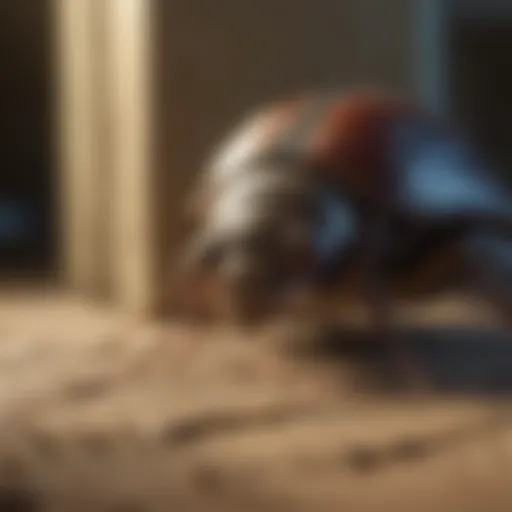Proven Strategies for Snake Removal and Prevention on Your Property


Preventive Pest Control Strategies
When it comes to keeping snakes away from your property, implementing preventive pest control strategies is key. Firstly, focus on your house exterior by sealing cracks and crevices that could serve as entry points for snakes. Clearing debris around your property is also crucial as clutter can attract pests which, in turn, may draw snakes closer to your home. Additionally, having a well-maintained yard plays a significant role in snake prevention. Regular yard care routines such as mowing the lawn and trimming shrubs help eliminate potential hiding spots for snakes. Indoor cleanliness is equally important, as clutter indoors can serve as shelter for pests that snakes may prey upon.
Efficient garbage disposal is another important aspect of preventing snakes from being attracted to your property. Proper waste management not only deters pests but also reduces the chances of snakes finding a food source near your home. Incorporating various pest prevention strategies beyond the basics can further safeguard your property from potential snake encounters.
Identifying Pest Risk Areas
To effectively tackle snake infestations, it's crucial to identify pest risk areas around your property. Start by inspecting moisture-prone areas that snakes are often drawn to. By addressing any damp conditions and taking preventive measures, you can significantly reduce the risk of snakes seeking refuge in those areas. Paying attention to cracks and crevices in and around your property is also essential. Regularly inspecting and sealing these access points can limit snakes' ability to enter your home.
Additionally, assessing the impact of greenery on attracting pests, including snakes, is important. By understanding how landscaping choices can influence pest activity, you can make informed decisions to minimize snake-attracting conditions in your yard. Don't overlook other pest risk areas that may serve as hiding spots for snakes; implementing preventive measures in these areas is equally crucial.
Effective Pest Control Methods
Utilizing the right pest control methods can be instrumental in keeping snakes at bay. Consider using natural repellents derived from essential oils, herbs, and plants that are known to deter pests, including snakes. Chemical sprays, when used safely and appropriately, can also aid in eradicating pests from your property. Deploying pest traps strategically can help capture and remove snakes without harming them, ensuring a humane approach to pest control.
Employing biological control methods that utilize natural predators of pests can contribute to a balanced ecosystem while keeping snake populations in check. Exploring innovative pest control methods beyond traditional options can offer additional layers of defense against snakes and other pests in your surroundings.
Pest Species Identification
Being able to identify common pests, including insects, rodents, birds, and wildlife, is crucial for effective pest management. Recognizing the signs of various pest infestations enables you to take targeted action to prevent them from escalating. Understanding the behaviors and characteristics of each pest species equips you with the knowledge needed to address specific pest issues proactively.
From ants and cockroaches to mice and rats, familiarizing yourself with these pests helps in implementing appropriate prevention measures. Addressing bird-related problems and knowing how to deal with wildlife encounters on your property contributes to creating a harmonious living environment free of pest disturbances. Even lesser-known pests should not be overlooked, as proactive management of these species can prevent potential infestations.
DIY Pest Control Techniques
DIY pest control solutions can offer a more hands-on approach to managing pests, including snakes, around your home. From creating homemade pest repellents using eco-friendly ingredients to utilizing essential oils for natural pest deterrence, a range of DIY methods can help in maintaining a pest-free environment. Setting up pest traps and barriers on your property can serve as effective preventive measures against snakes and other pests, providing an added layer of protection.
Exploring reputable pest control brands that offer safe and reliable products can further aid in safeguarding your home from snake infestations. By integrating various DIY pest control techniques tailored to specific pest issues, you can create a comprehensive pest management plan that aligns with your household needs and preferences.
Understanding Snake Behavior
Identifying Common Snakes
Research Local Snake Species
Researching local snake species is a fundamental aspect of identifying common snakes on your property. By understanding the types of snakes prevalent in your area, you can tailor your snake control efforts accordingly. Certain snake species may pose higher risks due to their venomous nature or specific habits. Knowing the behaviors of local snakes enables proactive measures to prevent encounters or remove them safely when necessary.


Recognizing Venomous Snakes
Recognizing venomous snakes is crucial for maintaining safety on your property. Being able to distinguish venomous snakes from non-venomous ones is essential in implementing appropriate precautions. Venomous snakes carry potential health risks, requiring immediate attention if encountered. Understanding the key characteristics that differentiate venomous snakes aids in swift and accurate identification, ensuring proper handling and avoidance.
Understanding Snake Habits
Understanding the habits of snakes contributes significantly to effective snake control. By learning about snake behaviors such as feeding patterns, nesting preferences, and movement tendencies, homeowners can predict and prevent snake encounters. Knowledge of snake habits guides the implementation of targeted strategies to deter snakes, reducing the likelihood of infestations on your property.
Factors Attracting Snakes
Food Sources
Food sources play a critical role in attracting snakes to your property. Snakes are drawn to areas abundant in prey like rodents, insects, or small animals. Eliminating food sources through proper waste management and controlling pest populations can deter snakes from frequenting your home. Understanding the importance of removing accessible food supplies is key to reducing snake activity in your surroundings.
Shelter and Hiding Spots
Providing shelter and hiding spots inadvertently attracts snakes seeking refuge or nesting sites. Overgrown vegetation, woodpiles, or cluttered areas offer ideal hiding places for snakes. By eliminating potential shelters like dense vegetation or debris, you can disrupt snake habitats, making your property less hospitable to these animals. Removing hiding spots reduces the likelihood of snakes establishing residency on your premises.
Water Availability
Water availability serves as a primary attractant for snakes searching for hydration and breeding sites. Ponds, leaky pipes, or standing water sources entice snakes to frequent your property. Controlling water sources by fixing leaks, draining ponds, or maintaining dry surroundings diminishes the attractiveness of your home to snakes. Addressing water availability issues mitigates the risk of snake infestations and creates a less appealing environment for these reptiles.
Preventive Measures
Preventive measures are crucial in dealing with snakes on your property. By implementing these strategies, you can create a snake-free environment that ensures the safety of your family and pets. Preventive measures not only eliminate existing snake problems but also act as a deterrent to future infestations. Taking proactive steps to secure your property and diminish attractive habitats for snakes can significantly reduce the risk of snake encounters and potential dangers they pose.
Securing Your Property
Sealing Cracks and Crevices
Sealing cracks and crevices is a fundamental aspect of securing your property against snakes. By addressing these entrance points, you can prevent snakes from infiltrating your home and creating potential dangers. The key characteristic of sealing cracks and crevices lies in its ability to block off easy access for snakes, thereby reducing the likelihood of their presence. This method is a popular choice due to its effectiveness in fortifying your property's defenses. Although sealing cracks and crevices requires diligence and attention to detail, its advantage in strengthening your property's integrity and keeping snakes at bay is unmatched.
Maintaining a Tidy Yard
Keeping a tidy yard is essential in snake control. A well-maintained yard reduces hiding spots for snakes and eliminates clutter where they can conceal themselves. The key characteristic of a tidy yard is its ability to create an open and clear environment that makes it less appealing to snakes seeking shelter. This method is popular for its simplicity and immediate impact on reducing snake habitats. While maintaining a tidy yard may require regular maintenance, its benefit in enhancing safety and deterring snakes from residing on your property is invaluable.
Installing Fencing


Installing fencing serves as a physical barrier to prevent snakes from entering your property. The key characteristic of fencing is its ability to create a perimeter that restricts snake access, adding an extra layer of defense to your property. This method is a beneficial choice for its ability to provide a visible boundary that discourages snakes from crossing into your living spaces. The unique feature of fencing lies in its versatility, as it can be customized to suit your property's layout and landscaping. While fencing may require an initial investment, its advantage in offering long-term protection and peace of mind against snakes is well worth the cost.
Snake Repellents and Deterrents
Natural Repellents
Essential Oils
Delving into natural repellents, essential oils emerge as a valuable asset in deterring snakes from your premises. The key characteristic of essential oils lies in their potent aromatic properties that snakes find displeasing, thus steering clear of treated areas. This natural approach stands out as a popular choice due to its environmentally friendly nature and safe usage around children and pets. However, the unique feature of essential oils, while effective, may require frequent reapplication to sustain their efficacy over time.
Clove and Cinnamon
A focus on clove and cinnamon as natural snake repellents amplifies the odor-centric strategy innate to these substances. The distinctive scent profile of clove and cinnamon disrupts a snake's sensory perception, prompting them to avoid spaces imbued with these fragrances. This method's appeal lies in its non-toxic nature, making it a preferred option for those inclined towards organic pest control solutions. It's worth mentioning that the intensity of these scents may diminish over time, necessitating periodic reapplications to uphold their repellent effect.
Garlic and Onion
Garlic and onion emerge as stalwart contenders among natural snake repellents, owing to their potent smell and repellent properties. The key characteristic of these kitchen staples lies in their sulfur-based compounds that emit a strong scent deterring snakes from lingering in treated areas. While a popular choice for eco-conscious individuals, the unique feature of garlic and onion may involve a pungent lingering aroma that some individuals may find unpleasant. Balancing the benefits of natural repellents like garlic and onion involves strategic placement and regular replenishment to ensure a sustained deterrent effect.
Commercial Repellents
Turning towards commercial alternatives, snake repellents take on a more formulated and targeted approach to snake deterrence. Incorporating chemical sprays as a potent defense mechanism against snake intrusion amplifies the efficacy of repellents by leveraging synthetic compounds that repel snakes. The key characteristic of chemical sprays lies in their long-lasting formula that provides extended protection against snake encroachment. While chemical sprays offer heightened efficacy, considerations around their environmental impact and potential harm to non-target species necessitate judicious use and adherence to application instructions.
Ultrasonic Devices
Ultrasonic devices present a technological leap in snake deterrence, utilizing high-frequency sound waves to disrupt a snake's sensory perception and drive them away from the designated area. The key characteristic of ultrasonic devices lies in their non-invasive method of deterring snakes, appealing to homeowners seeking a discreet solution to snake infestations. Despite their effectiveness, the unique feature of ultrasonic devices may involve limited coverage area and potential interference from household objects that can impede their repellent capabilities.
Motion-Activated Sprinklers
Motion-activated sprinklers stand out as innovative deterrents in the battle against snakes, employing sudden bursts of water triggered by snake movement to startle and repel these reptiles. The key characteristic of motion-activated sprinklers lies in their behavioral deterrence approach that capitalizes on snakes' aversion to water and sudden movement. While offering a humane and non-lethal method of snake control, considerations must be given to potential water wastage and false activation caused by non-targeted movements.
Snake Removal Techniques
Snake removal techniques are a crucial aspect of ensuring a safe and snake-free environment on your property. Implementing the right strategies for removing snakes effectively can protect your home and family from potential risks. In this section, we will delve into the different methods and approaches to handling snake infestations with precision and care.
Professional Assistance
Hiring Exterminators


Hiring professional exterminators is a highly recommended approach when dealing with snake removal. These experts have the knowledge, experience, and tools necessary to identify snake habitats, locate infestations, and safely remove snakes from your property. Their expertise in dealing with various snake species ensures an efficient and effective removal process. One of the key characteristics of hiring exterminators is their ability to provide targeted solutions tailored to your specific snake issue. This specialized approach reduces the risks associated with snake removal and ensures thorough elimination of snakes. While hiring exterminators may involve a cost, the benefits of their services in ensuring complete and safe snake removal make it a popular choice for those seeking professional assistance.
Contacting Wildlife Services
Contacting wildlife services is another valuable option for addressing snake infestations on your property. Wildlife services professionals are trained to handle wildlife-related issues, including snake removal, in a humane and safe manner. They offer expertise in identifying snake species, assessing infestation levels, and implementing effective removal strategies. A key characteristic of wildlife services is their focus on wildlife conservation and ethical treatment of animals, ensuring that snakes are removed without harm to the environment or other wildlife. While contacting wildlife services may require coordination and scheduling, the unique feature of their services lies in their comprehensive approach to wildlife management. This approach minimizes the chances of recurring snake problems and promotes long-term property safety.
Seeking Expert Advice
Seeking expert advice from snake removal specialists or wildlife professionals is an essential step in effectively addressing snake infestations. Experts can provide valuable insights into identifying snake habitats, implementing preventive measures, and safely removing snakes from your property. Their expertise in understanding snake behavior and habits allows them to offer personalized advice tailored to your unique situation. A key characteristic of seeking expert advice is the access to specialized knowledge and resources that can enhance your snake removal efforts. While seeking expert advice may involve consultation fees, the advantages of gaining valuable expertise and guidance in managing snakes outweigh the potential costs. By seeking expert advice, you can benefit from informed strategies and recommendations that support effective snake removal and long-term prevention.
DIY Removal Methods
Using Snake Traps
Using snake traps is a practical and humane method for removing snakes from your property. Snake traps are designed to capture snakes safely without causing harm, allowing you to relocate the captured snake away from your home. One key characteristic of using snake traps is their non-toxic and non-invasive nature, making them a popular choice for homeowners seeking DIY removal solutions. The unique feature of snake traps is their effectiveness in targeting specific snake species while minimizing risks to other wildlife. While using snake traps requires patience and monitoring, the advantages of capturing snakes without harm to the environment or pets make it an appealing DIY removal method.
Creating Exclusion Barriers
Creating exclusion barriers is a proactive approach to preventing snake infestations by blocking their access points to your property. These barriers can include sealing gaps in structures, installing snake-proof fencing, and reducing vegetation near buildings. A key characteristic of creating exclusion barriers is the focus on deterring snakes from entering your property, thereby reducing the likelihood of infestations. The unique feature of exclusion barriers is their long-term effectiveness in preventing snake incursions and maintaining a snake-free environment. While creating exclusion barriers may require upfront effort and investment, the advantages of safeguarding your property against snakes outweigh the potential maintenance costs.
Implementing Safe Capture Methods
Implementing safe capture methods is essential when handling snakes on your property without professional assistance. Safe capture methods involve using proper equipment and techniques to capture snakes safely and securely. One key characteristic of implementing safe capture methods is the emphasis on minimizing harm to both the snake and the handler during the removal process. The unique feature of safe capture methods is their applicability in various scenarios, from indoor snake encounters to outdoor sightings. While implementing safe capture methods necessitates caution and preparation, the benefits of safely removing snakes from your property and avoiding potential risks make it a practical DIY approach to snake removal.
Ensuring Safety and Long-Term Prevention
Ensuring safety and long-term prevention are crucial elements when dealing with snakes on your property. By implementing effective strategies, you can create a safe environment for your family. It is essential to focus on specific elements such as regular inspections, education, and awareness to maintain a snake-free space.
Regular Inspections
Regular inspections play a vital role in preventing snake infestations. By conducting periodic property checks, you can identify potential entry points for snakes and take necessary measures to seal them off. This proactive approach helps in early detection of snake presence, ensuring timely actions to eliminate any threats. Periodic property checks contribute significantly to the overall goal of maintaining a snake-free environment.
Vigilance in high-risk areas is another key aspect of regular inspections. By paying close attention to known hotspots where snakes are likely to reside, you can proactively safeguard those areas to prevent snake intrusion. This focused monitoring helps in reducing the risk of snake encounters, especially in areas with favorable snake habitat. Vigilance in high-risk areas is a popular choice for its effectiveness in snake prevention.
Professional inspections provide a more in-depth assessment of your property's susceptibility to snake infestations. By enlisting the expertise of professionals, you can benefit from thorough evaluations and customized recommendations to fortify your home against snakes. Professional inspections offer detailed insights into potential snake entry points and suggest tailored solutions for long-term prevention. While professional inspections may incur additional costs, the advantages of comprehensive protection against snakes make them a valuable investment.
Educating Your Household
Educating your household on snake safety measures is essential for fostering a culture of preparedness. Teaching safety measures such as how to identify snakes, proper behavior in snake encounters, and emergency response protocols empower your family members to respond effectively in snake-related situations. This knowledge equips them with the necessary skills to mitigate risks and ensure their safety.
Developing emergency response plans is a proactive approach to handling snake emergencies. By outlining clear procedures for snake encounter scenarios, you can streamline efficient responses and minimize confusion in high-stress situations. Emergency response plans should include steps on contacting relevant authorities, administering first aid if needed, and evacuating the area safely. Having a well-defined plan in place ensures swift and coordinated actions during snake incidents.
Creating awareness within your household about snake behavior and prevention tactics is key to maintaining a vigilant environment. By fostering a shared understanding of snake habits, potential risks, and preventive measures, every member of the household becomes a proactive participant in snake control efforts. Raising awareness through regular communication and practical drills reinforces a culture of preparedness and safety consciousness among family members.



